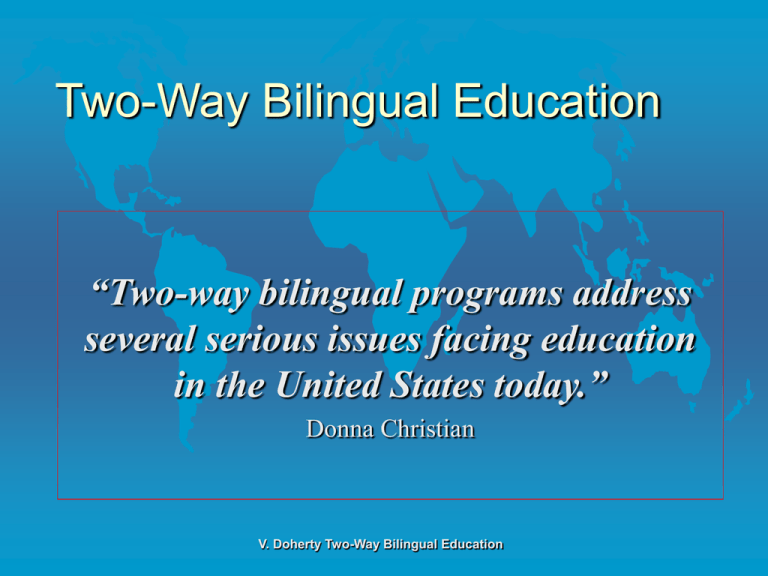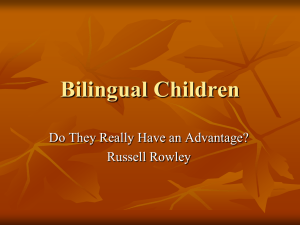PowerPoint Presentation - Two-Way Bilingual Education
advertisement

Two-Way Bilingual Education “Two-way bilingual programs address several serious issues facing education in the United States today.” Donna Christian V. Doherty Two-Way Bilingual Education Differing opinions Only by preserving our commonality-English--can we ensure that we will continue to live and work together as one Nation, one people. Toby Roth, 1993 Proficiency in two or more languages should be promoted for all American students. Bilingualism enhances cognitive and social growth, competitiveness in a global marketplace, national security, and understanding of diverse peoples and cultures. Stanford report,1993 Crawford states that this schizophrenic attitude can be summed up as “additive bilingualism for English speakers and subtractive bilingualism for language minorities”. (p.210) Agenda Essential definitions Brief review of language support programs Characteristics of a dual language program Look at dual language programs in terms of Wirt and Kirst’s values in education policy Activity to bring it all together and to bring out any questions you have. Definitions Bilingual education – Transitional (aims to prepare students to enter the mainstream classroom by using the home language to ‘transition’ into English instruction) – Developmental (aims to maintain and develop the home language as students acquire English) Two-way bilingual education places two language groups together and promotes the learning of a second language while maintaining the home language. Programs and Percentages ESL (pull-out and pull-out with content) - 64% Transitional bilingual education programs - 26% Developmental bilingual education programs - 10% According to Collier & Thomas (1997) of the 10% who were in developmental bilingual education programs, only 3% were in dual language, or two-way bilingual programs. Cummins, J. (2000). Language, Power and Pedagogy: Bilingual children in the crossfire. Clevedon, UK: Multilingual Matters. “The quick-exit orientation, though still pervasive, is beginning to face a challenge from parents, educators and even some federal policymakers.” Crawford, J. (1999). Bilingual education: History, politics, theory and practice (4th ed.). Los Angeles: Bilingual Educational Services. A change is in the air… Research is starting to document the benefits of extended mother-tongue instruction to ELLs (Collier & Thomas, 1997, 2002) Foreign language immersion programs show superior results for English-speaking students (Lindholm & Aclan, 1991) Parents requesting more enrichment programs (Cloud, Genesee, Hamayan, 2000) Crawford, J. (1999). Bilingual education: History, politics, theory and practice (4th ed.). Los Angeles: Bilingual Educational Services. Is there a way to reconcile the needs of the English language learners and the native English speakers? YES A dual language program What is a dual language program? A B C D E Additive Bilingual Curriculum-based Developmental Enrichment oriented Goals of a dual language program: Students will develop high levels of proficiency in their first language and in a second language. Students will perform at or above grade level in academic areas in both languages. Students will demonstrate positive crosscultural attitudes and behaviors and high levels of self-esteem. Christian, D. 1994 Criteria for Effective Two-Way Bilingual Education Crawford, J. (1999). Bilingual education: History, politics, theory and practice (4th ed.). Los Angeles: Bilingual Educational Services. V. Doherty Two-Way Bilingual Education Long-term treatment Research has shown that it takes 4-6 years for students to achieve bilingual proficiency. V. Doherty Two-Way Bilingual Education Optimal input in two languages Subject-matter instruction must be -adjusted to the students’ level - challenging - relevant in both languages. Integration of language arts into the curriculum Students need formal language arts instruction in both languages. This should be done through content areas, rather than through grammar exercises. V. Doherty Two-Way Bilingual Education Separation of languages for instruction This can be done by subject matter, physical space or by teacher. This can also be done by days of the week, or time of day (a.m. instruction in one language, p.m. instruction in the other). Additive bilingual environment The goals of a two-way bilingual program stress the development of two languages, not using one language just to learn the other. V. Doherty Two-Way Bilingual Education Balance of language groups The ideal ‘mix’ is 50/50 to ensure equity in the classroom. A balanced mix ensures maximum interaction in the classroom between the two language groups. Sufficient use of the minority language At least 50% of instruction should be in the minority language to provide English speaking students optimal input and to give the language minority students opportunity to develop academic proficiency in their language. V. Doherty Two-Way Bilingual Education Oyster elementary in Washington, D.C. introduces reading in both languages at the same time. By 3rd grade, their children are reading above grade level. V. Doherty Two-Way Bilingual Education Virginia Collier (parent of an Oyster graduate) attributes the children’s high literacy ability to ‘affirmation of the minority language,…because the whole school community is reinforcing that Spanish is as good as English”. Crawford, J. (1999). Bilingual education: History, politics, theory and practice (4th ed.).Los Angeles: Bilingual Educational Services. V. Doherty Two-Way Bilingual Education Oyster is far from the typical school Oyster elementary has two teachers for every class. One is the Spanish teacher and the other the English teacher. The children who go to Oyster are of relatively high socioeconomic status. Crawford, J. (1999). Bilingual education: History, politics, theory and practice (4th ed.).Los Angeles: Bilingual Educational Services. V. Doherty Two-Way Bilingual Education Integration of the dual language program into the whole school so that the program does not become a ‘school within a school’ into the community so that there is participation of other minority/majority language speakers in program activities into the families so that volunteering in the program encourages socializing among both groups of parents. Program models Programs are described by the percentage of the minority language first. For example: 90/10 means that the minority language is used for instruction 90% of the instructional day and English 10%. Programs can be 90/10, 80/20, 70/30, 60/40 or 50/50. V. Doherty Two-Way Bilingual Education Any questions on: Goals of a two-way bilingual program? Important elements of a well-designed program? Types or models of dual language programs? Challenges in establishing dual language programs Finding qualified teachers Lack of understanding about the goals of a bilingual program Funding the added costs of teacher recruitment and two sets of content materials More information on TWI programs www.cal.org/twi (Two-Way Immersion 101) www.cal.org/jsp/TWI/SchoolView.jsp (Directory of Two-Way Immersion programs throughout the U.S. How does a dual language program relate to Wirt and Kirst’s four values in education policy? • • • • Quality Efficiency Equity Choice ACTIVITY A final thought Perhaps some day, to become Americanized will no longer mean to become monolingual. James Crawford V. Doherty Two-Way Bilingual Education








